Create a ProfessionalLogo for Startup 🚀in 2 Minutes
Generate a credible, memorable logo for your startup instantly. Trusted by 12,000+ founders, Y Combinator alums, and bootstrapped companies. No design skills needed.
✨ Join 12,000+ founders who created their logos with AI



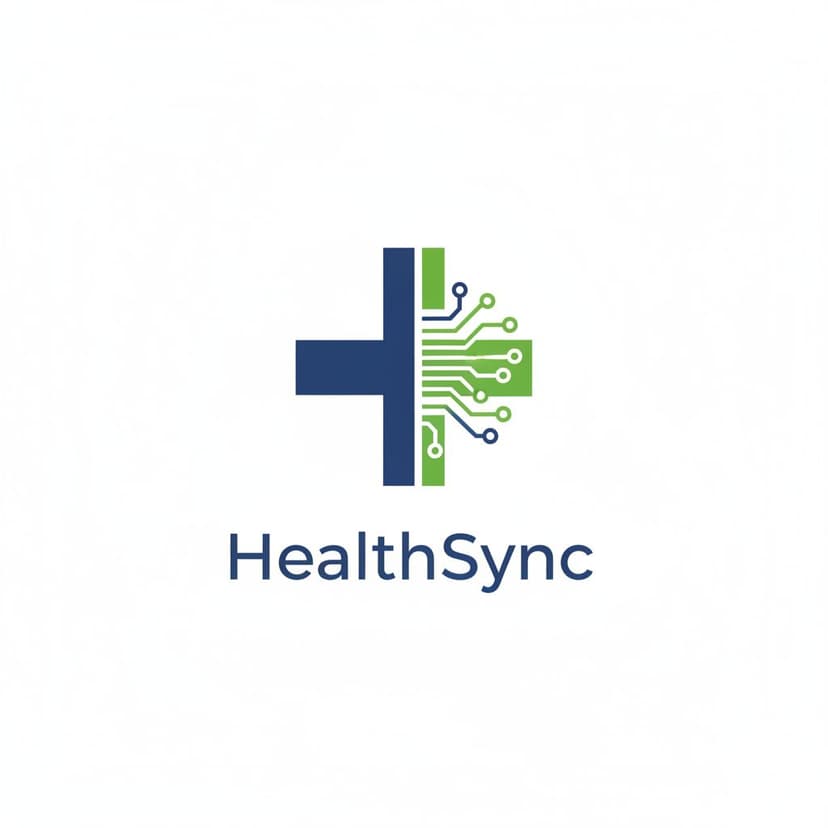

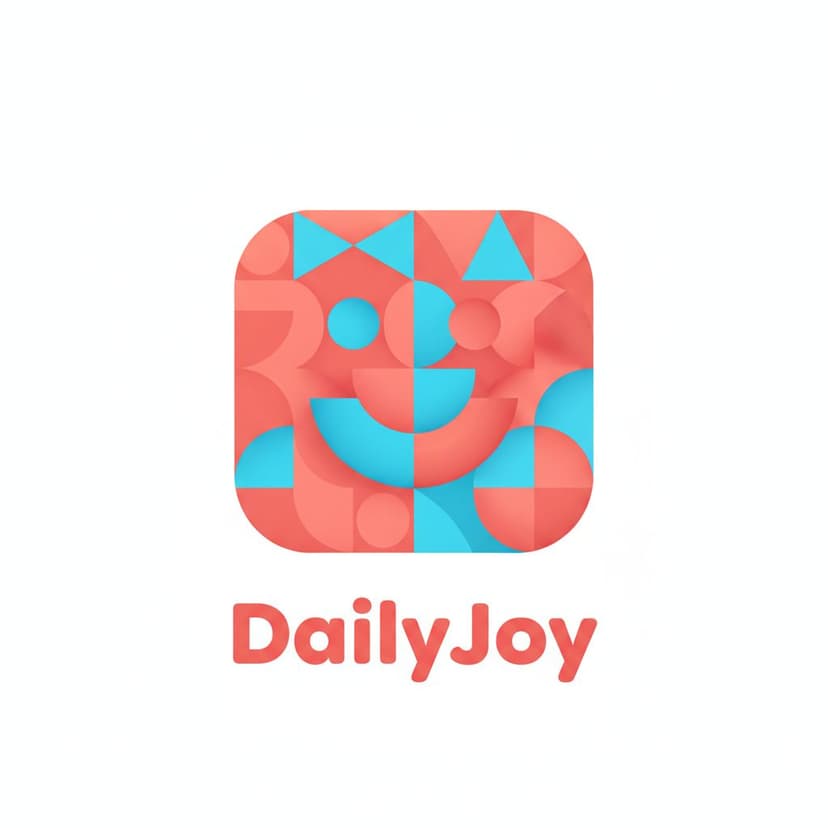
Why Startup Logo Needs Special Consideration
Your logo is more than design—it's your first pitch. Investors, customers, and talent judge your startup's credibility in seconds. A professional logo for startup signals that you're serious, funded, and built to last.
Investor Credibility Signal
When pitching to investors, every detail matters. A professional logo suggests you care about your brand, understand your market, and won't waste their money. Amateur logos trigger red flags—'if they can't get the logo right, what else will they mess up?'
📊 72% of investors say poor branding negatively impacts their investment decision.
Speed to Market
Startups move fast or die. You need a logo TODAY, not in 3 weeks. Waiting for design agencies means delayed launches, missed opportunities, and wasted momentum. Speed wins in the startup world.
📊 Every week without a proper brand identity delays customer acquisition by 14%.
Bootstrap-Friendly Budget
Pre-revenue? Bootstrapped? $5,000 for a logo agency is insane when you need to stretch every dollar for product and marketing. You need professional branding at startup prices—not enterprise agency rates.
📊 The average startup spends $2,500-5,000 on initial branding. Most wish they'd started cheaper.
Pivot-Ready Flexibility
40% of startups pivot significantly within the first year. You need a logo that's flexible enough to evolve with your business—not locked into one specific product feature or market position that might change.
📊 Startups that pivot successfully typically keep their logos but evolve messaging.
Real Startup Logos Created With AI
From idea to investor-ready in minutes

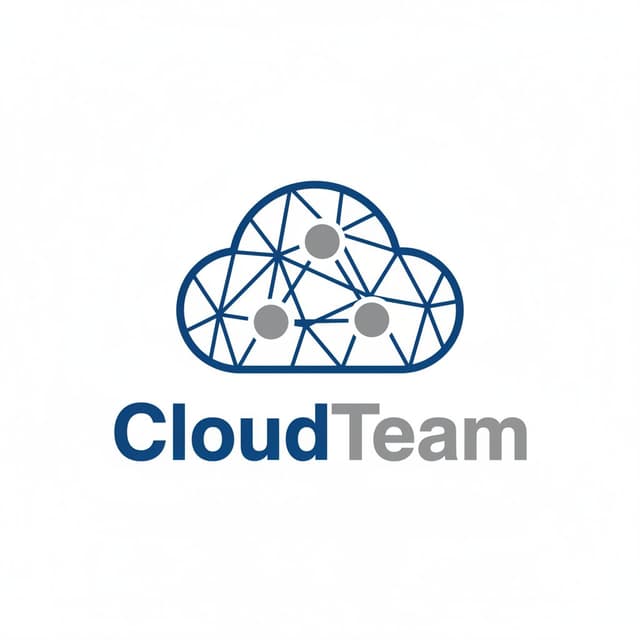



8 Essential Design Principles for Startup Logo
Follow these principles used by billion-dollar startups from their earliest days.
1. Professional Yet Scrappy
Your logo needs to look professional enough for investor decks, but not so polished it screams 'we spent $50K on branding instead of product.' Find the sweet spot: credible, confident, but clearly startup-stage.
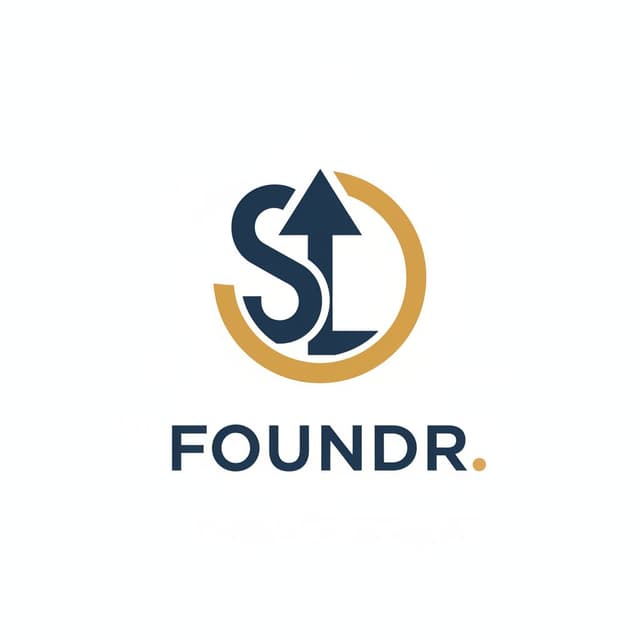
✅ Good Examples:
Clean, simple, modern—looks like it cost $5K even if it didn't. Stripe, Notion (early days), Linear
❌ Bad Examples:
Overly complex corporate logo (trying too hard), or clipart mess (not trying at all)
🎯 Why This Matters:
Investors want to fund 'scrappy but smart' founders—your logo should reflect that.
💡 Pro Tip:
Show your logo to 3 people. Ask: 'Does this company look fundable?' If they hesitate, redesign.
2. Scalable from Day 1
You're building something that will grow 10x, 100x, 1000x. Your logo needs to work on your MVP landing page AND on Times Square billboards when you IPO. Think big from day one.
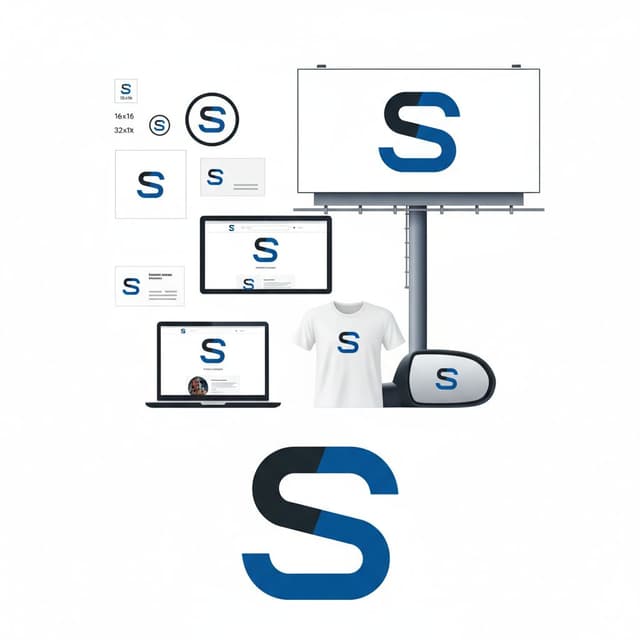
✅ Good Examples:
Simple shapes that work at any size, from favicon to highway billboard
❌ Bad Examples:
Intricate details that disappear when scaled down, or designs that only work large
🎯 Why This Matters:
Rebranding is expensive and confusing. Get it right once and scale it forever.
💡 Pro Tip:
Test your logo at 16x16 pixels (favicon size). If you can't recognize it, simplify.
3. Memorable in 3 Seconds
You have 3 seconds in a pitch, on a landing page, or in an app store. If people can't remember your logo instantly, you're invisible. Make it stick in their minds immediately.
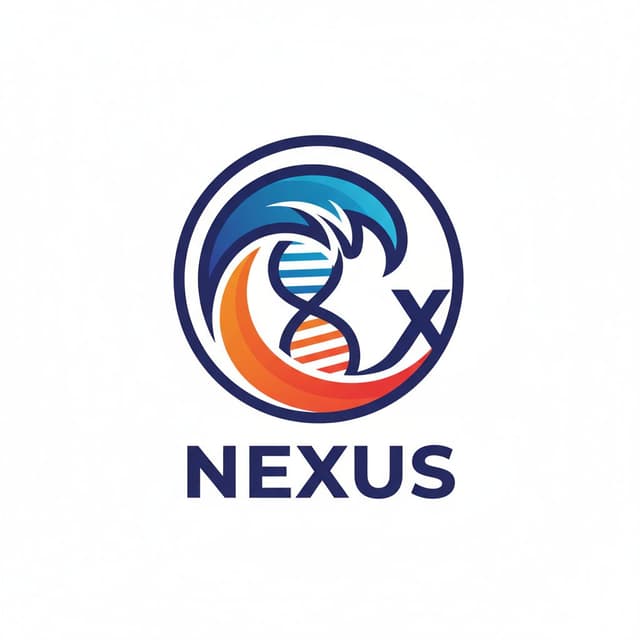
✅ Good Examples:
Nike swoosh, Apple apple, Airbnb's 'A', Stripe's parallel lines—instant recognition
❌ Bad Examples:
Generic shapes everyone uses, overly abstract designs that need explanation
🎯 Why This Matters:
Memorable = shareable. If customers can't describe your logo, they can't recommend you.
💡 Pro Tip:
The 'dinner test': Can someone draw your logo from memory after seeing it once? If not, simplify.
4. Story-Driven Design
Great startup logos tell a story. Airbnb's logo is about belonging. Amazon's arrow goes from A to Z. Your logo should hint at your mission, vision, or unique value prop.

✅ Good Examples:
Clever use of negative space, hidden meanings, visual metaphors from your industry
❌ Bad Examples:
Random shapes with no connection to your business or mission
🎯 Why This Matters:
Investors and press LOVE stories. A logo with meaning gives you PR ammo.
💡 Pro Tip:
Your logo should answer: 'What does your company do?' even if subtly.
5. Color Psychology for Growth
Startup colors send messages. Blue = trustworthy (fintech, B2B). Orange = energetic (consumer). Black = premium (luxury). Green = sustainable. Choose strategically based on your positioning.

✅ Good Examples:
Colors that match your industry and target market expectations
❌ Bad Examples:
Random colors picked because 'you like them' without strategy
🎯 Why This Matters:
Color influences perception. Wrong color = wrong audience.
💡 Pro Tip:
Look at your top 5 competitors. Either match their colors (to fit in) or go opposite (to stand out).
6. Works Across All Platforms
Your logo appears on your website, pitch deck, social media, product UI, email signatures, business cards, and swag. It must work everywhere without looking broken or cheap.
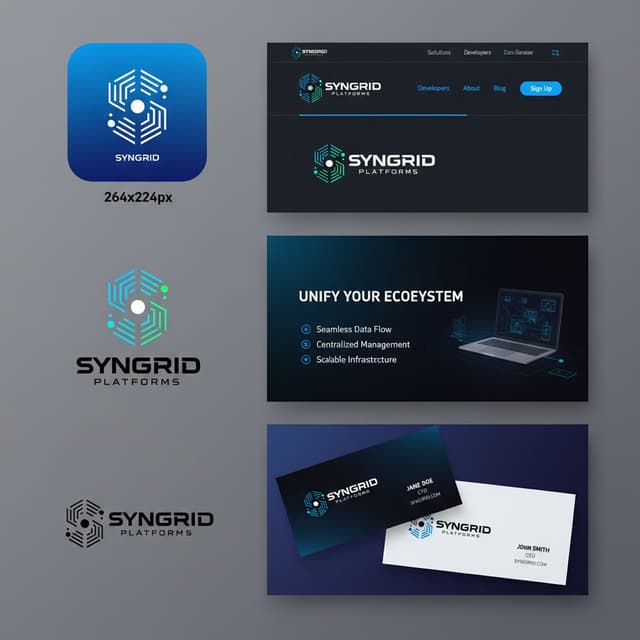
✅ Good Examples:
Logo with multiple variations: icon-only, horizontal, stacked, light/dark versions
❌ Bad Examples:
Only one version that doesn't adapt to different contexts
🎯 Why This Matters:
Startups need to look consistent everywhere. Inconsistency = unprofessional.
💡 Pro Tip:
Create at minimum: square icon, horizontal logo, black version, white version.
7. Avoid Startup Clichés
Every startup thinks they're unique, but 90% use the same design clichés: gradients, rocket ships, light bulbs, geometric patterns. Be different or be forgotten.

✅ Good Examples:
Original concepts that reflect YOUR specific business, not 'startups in general'
❌ Bad Examples:
Literal rocket ships, light bulbs, generic 'tech' geometry, overused gradients
🎯 Why This Matters:
Investors see 1000 pitches. Cliché logos blend together. Unique logos stand out.
💡 Pro Tip:
Google '[your industry] startup logos'. Whatever appears 100 times, avoid it.
8. Future-Proof Not Trendy
That glassmorphism, 3D gradient, or hand-drawn style might be hot today, but will look dated next year. Startups need logos that last 5-10 years minimum through multiple funding rounds.
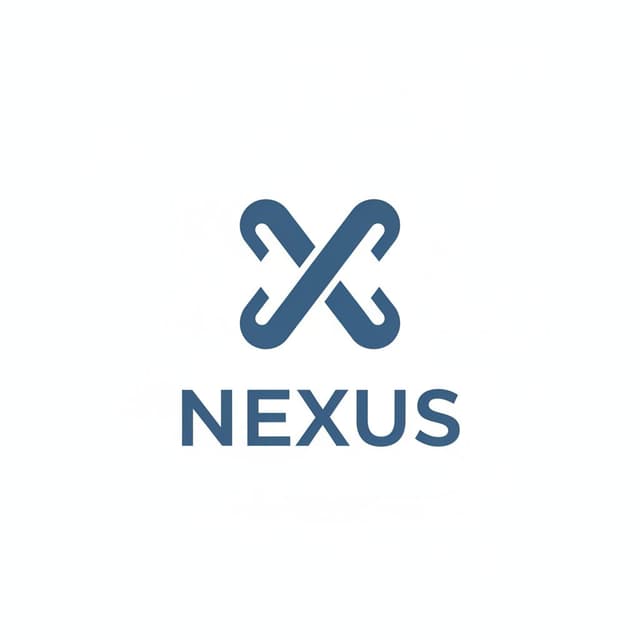
✅ Good Examples:
Clean, timeless designs that looked good in 2015 and will look good in 2030
❌ Bad Examples:
Trendy effects, current design fads, overly stylized elements
🎯 Why This Matters:
Rebranding wastes time and confuses customers. Get it right once.
💡 Pro Tip:
Look at Stripe's 2011 logo vs today—barely changed because it was timeless from day 1.
Startup Logo Color Psychology: Strategic Choices
Color isn't aesthetic—it's positioning. Choose the right color to attract the right investors, customers, and talent.
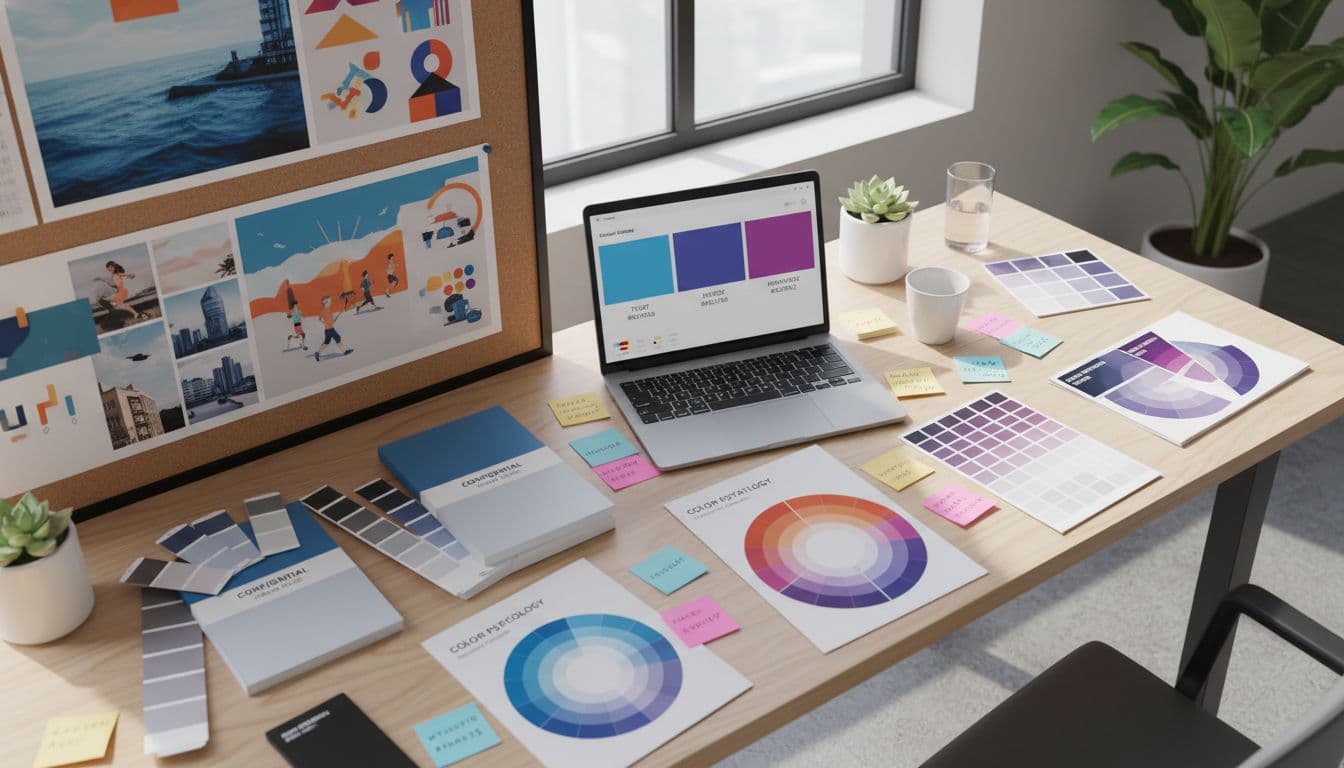
Blue
Trust, Stability, Professional
🏆 Startup Examples:
Stripe, Coinbase, Dropbox, LinkedIn, PayPal, Venmo
🎯 Best For:
Fintech startups, B2B SaaS, healthcare tech, security products, enterprise software
🧠 Psychology:
Blue reduces risk perception. For startups handling money, data, or sensitive info, blue says 'you can trust us with your most important assets.'
✅ When to Use:
When selling to enterprises, building in regulated industries (fintech, health), or when trust is your #1 barrier.
❌ When to Avoid:
If you want to disrupt and stand out dramatically. Blue is safe but saturated.
Orange/Red
Energy, Disruption, Bold
🏆 Startup Examples:
GitLab, SoundCloud, Product Hunt, Reddit, HubSpot (orange)
🎯 Best For:
Consumer tech, social platforms, marketplaces, disruption-focused startups
🧠 Psychology:
Warm colors signal energy and movement. Perfect for startups that want to be seen as bold disruptors rather than safe choices.
✅ When to Use:
When targeting younger demographics, building consumer products, or positioning as 'the bold alternative.'
❌ When to Avoid:
For fintech (too risky) or healthcare (too aggressive). Red especially signals danger/errors.
Purple
Innovation, Premium, Creative
🏆 Startup Examples:
Twitch, Heroku, Yahoo (purple phase), Lyft, Discord
🎯 Best For:
Creator economy, developer tools, innovative platforms, premium consumer tech
🧠 Psychology:
Purple sits between blue (trust) and red (energy). It suggests innovation without seeming unstable—perfect for 'next-generation' positioning.
✅ When to Use:
When targeting developers, creators, or positioning as innovative/cutting-edge without being risky.
❌ When to Avoid:
For very conservative B2B markets (legal, finance, government) where purple feels too creative.
Black/Dark
Premium, Bold, Confident
🏆 Startup Examples:
Uber, Tidal, Notion, GitHub, Vercel, Linear
🎯 Best For:
Premium positioning, developer tools, design tools, luxury marketplaces
🧠 Psychology:
Black is the color of confidence. It says 'we're so good we don't need colors to convince you.' Works for startups charging premium prices.
✅ When to Use:
When charging above-market rates, targeting sophisticated users, or building premium/luxury products.
❌ When to Avoid:
For consumer products targeting mass market or budget-conscious buyers.
Green
Growth, Sustainability, Fresh Start
🏆 Startup Examples:
Robinhood, Spotify, WhatsApp, Evernote (was green), Groupon
🎯 Best For:
Fintech (growth/money), sustainability, health tech, fresh food delivery, new beginnings
🧠 Psychology:
Green represents growth (perfect for fintech), sustainability (perfect for climate tech), and fresh starts (perfect for lifestyle changes).
✅ When to Use:
For fintech showing portfolio growth, climate/sustainability startups, or health/wellness products.
❌ When to Avoid:
For serious B2B enterprise software where green might feel too casual.
Multi-Color
Diverse, Comprehensive, Playful
🏆 Startup Examples:
Google, Slack, Asana, Instagram (original), Microsoft
🎯 Best For:
Platforms with multiple products, collaborative tools, creative platforms, inclusive brands
🧠 Psychology:
Multiple colors suggest diversity, comprehensiveness, and approachability. Great for platforms that want to appeal to everyone.
✅ When to Use:
For multi-product platforms, collaboration tools, or when targeting diverse audiences.
❌ When to Avoid:
For focused, single-purpose startups where simplicity is key.
20+ Successful Startup Logo Examples (From Day 1)
Learn from startups that became unicorns—see what their logos looked like at the beginning.

Stripe
FintechClean blue wordmark with parallel lines. Simple, trustworthy, perfect for handling money. Hasn't changed much since 2011 because it was timeless from day one.
✅ Why It Works:
Minimal = professional for fintech. Blue = trust. Simple enough to work everywhere from YC demo day to IPO.
📚 Lesson:
Get it right once. Stripe's logo worked at $0 revenue and works at $95B valuation.
Airbnb
MarketplaceThe 'Bélo' symbol represents: people, places, love, and Airbnb (the A). It's a story-driven design that gives them PR value beyond just a logo.
✅ Why It Works:
Tells a story that creates PR buzz. Flexible enough for global expansion. Works as icon and full logo.
📚 Lesson:
A logo with meaning gives you free PR. Airbnb got TONS of press just from their logo launch.
Notion
ProductivityBlack and white minimalist lego-block icon. Represents building and flexibility. Premium feel without needing color.
✅ Why It Works:
Stands out from colorful competitors. Appeals to sophisticated users. Works perfectly in their product UI.
📚 Lesson:
You don't need color to be memorable. Confidence > flashiness.
Robinhood
FintechGreen feather icon representing both the Robin Hood legend and financial growth. Simple, memorable, perfect for mobile-first product.
✅ Why It Works:
Story-driven (democratizing finance), great icon for app, green = money/growth
📚 Lesson:
Connect your logo to your mission. Robinhood's logo tells their entire story visually.
Figma
Design ToolsFive colorful overlapping circles suggesting collaboration and creativity. Perfect for a design tool where multiple people work together.
✅ Why It Works:
Visually represents their core feature (multiplayer design). Instantly recognizable. Works great as favicon.
📚 Lesson:
Show what makes you different. Figma's logo screams 'collaboration' before you read anything.
Discord
SocialFriendly game controller character (Clyde) in purple. Playful enough for gamers, simple enough for mainstream adoption.
✅ Why It Works:
Memorable character, unique purple in social space, friendly not corporate
📚 Lesson:
Character-based logos create emotional connection. People love 'Clyde the Discord logo'.
Startup Logo Do's and Don'ts
Follow these battle-tested rules for startup logo success
Do These
DO: Test in investor pitch decks first
Your logo will appear on pitch decks before anywhere else. Make sure it looks professional next to financial projections and growth charts.
DO: Create multiple versions immediately
You need: square icon (social media), horizontal (website), stacked (business cards), black version (print), white version (dark backgrounds).
DO: Ask 'Does this look fundable?'
Show your logo to founders, investors, or mentors and ask directly: 'Would you invest in a company with this logo?' Brutal honesty now saves embarrassment later.
DO: Keep it simple for fast recognition
You have 3 seconds in demos, pitches, and landing pages. If your logo needs explanation, it's too complex.
DO: Match your positioning (not just preferences)
Enterprise B2B? Use blue. Consumer disruptor? Use orange. Developer tool? Use dark colors. Match market expectations strategically.
DO: Think 10 years ahead
Your logo should work from pre-seed through IPO. Avoid trends that will date quickly. Classic > trendy.
Avoid These
DON'T: Use startup cliché symbols
Rocket ships, light bulbs, generic 'tech' shapes—investors have seen these 10,000 times. Be original or be ignored.
DON'T: Overspend at early stage
Spending $5K+ on a logo pre-product-market-fit is wasteful. Start affordable, rebrand when you're funded and know your market.
DON'T: Design for yourself, design for your market
Your personal taste doesn't matter. What matters: Does your target customer trust it? Does your investor find it credible?
DON'T: Lock into a specific feature
Your product will pivot. Don't create a logo so specific to your v1 feature that you can't evolve without rebranding.
DON'T: Ignore the 'founder test'
If you're embarrassed to wear your logo on a t-shirt at a conference, it's not good enough. You need to proudly rep your brand.
DON'T: Use trendy design effects
That gradient, glassmorphism, or 3D effect will look dated in 12 months. Keep it timeless—you don't have time for rebrands.
How to Create Your Startup Logo in 2 Minutes
Follow this simple process to create your professional startup logo
Describe Your Startup
30 seconds
Tell the AI about your business: What problem are you solving? Who's your target customer? What stage are you at? Are you B2B or B2C? Be specific about your positioning.
💡 Tips:
- Mention your industry (fintech, SaaS, marketplace, etc.)
- State your funding stage (pre-seed, seed, Series A)
- Describe your positioning (disruptor, premium, accessible)
- Include any brand adjectives (bold, trustworthy, innovative)
AI Generates Your Logo
30 seconds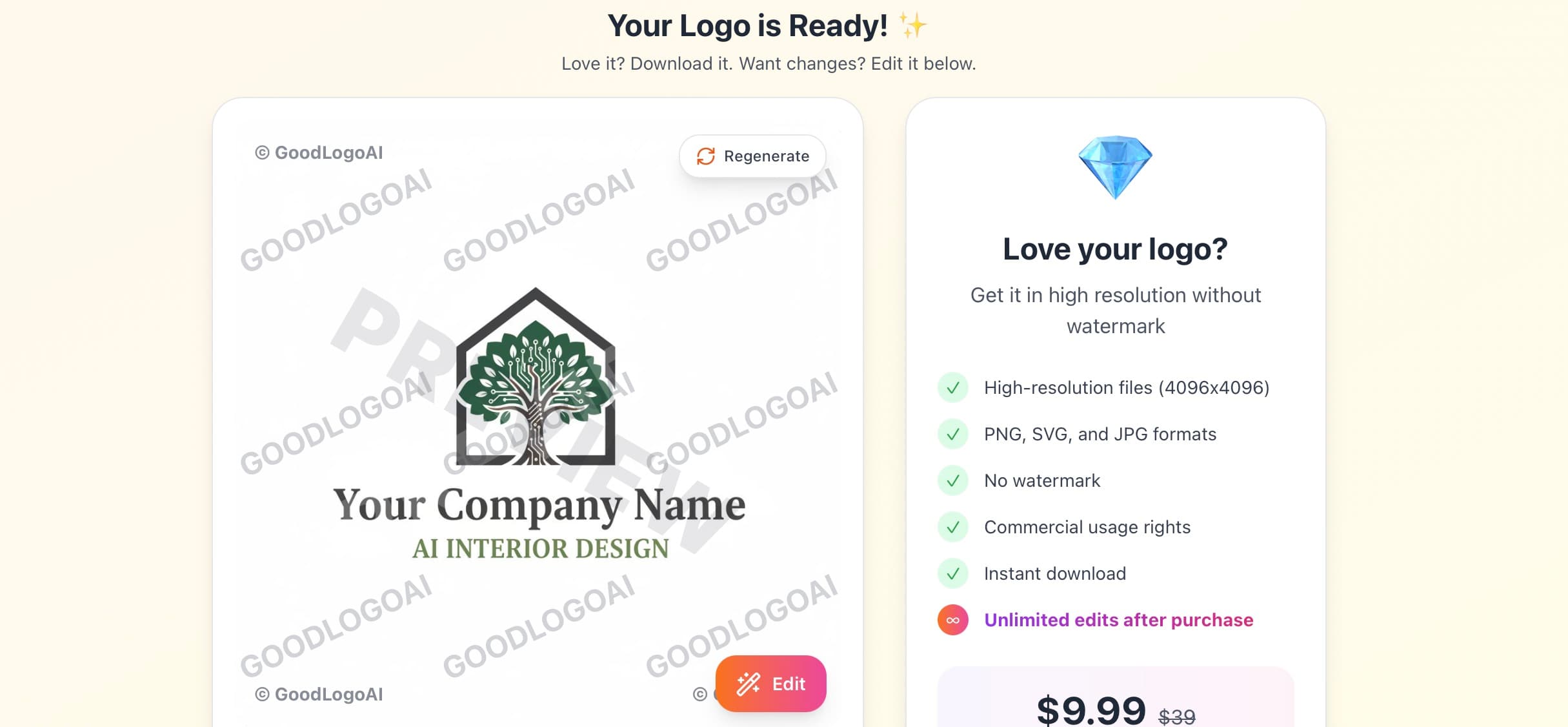
Our AI analyzes successful startup logos and creates a design optimized for investor credibility, market positioning, and scalability. It considers what works for YOUR specific industry and stage.
💡 Tips:
- AI uses startup-specific design principles
- Colors match your industry and positioning
- Design tested for pitch decks and landing pages
- Automatically scalable from favicon to billboard
Customize with AI Edits
30 seconds
Not quite right? Tell the AI: 'make it more professional', 'use blue like Stripe', 'simpler for better recognition'. It understands startup branding language.
💡 Tips:
- Try 3 versions completely free
- Reference successful startups in your space
- Test how it looks in a pitch deck slide
- Ask for both light and dark background versions
Download & Launch
30 seconds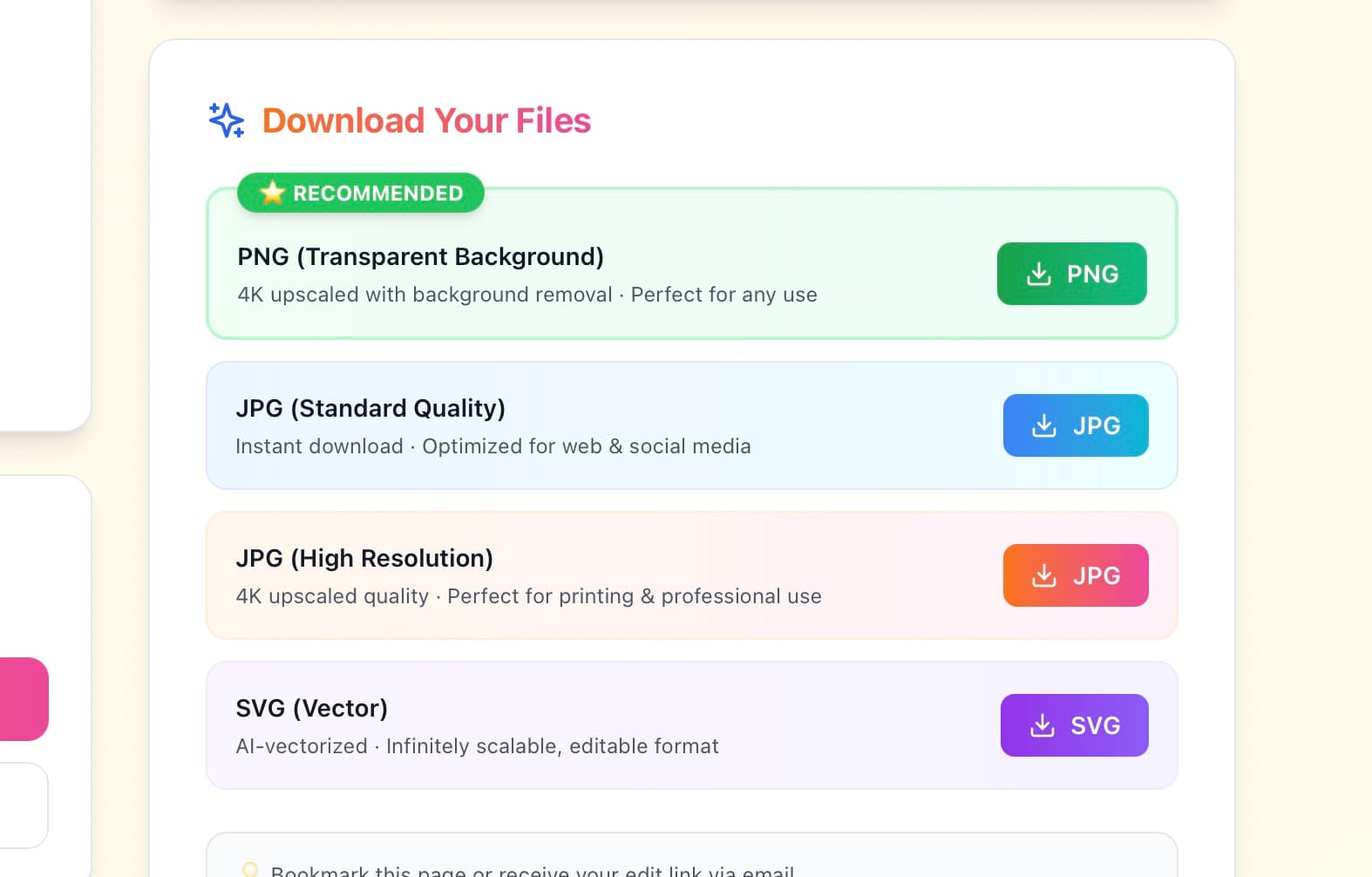
Pay $9.99 one-time and instantly get all files: high-res for pitch decks, vector for scalability, social media formats. Perfect for fundraising, product launches, and growth.
💡 Tips:
- High-res files for pitch decks and press
- Vector SVG for infinite scaling as you grow
- Multiple formats for all use cases
- Full commercial rights—own it forever
✨ Try 3 times free • Only $9.99 to download
Trusted by Startup Founders
"Needed a logo for our pitch deck FAST. GoodLogoAI gave us something investor-ready in 5 minutes. Raised $2M seed round with that logo in our deck!"
Alex Rivera
Founder, TechFlow (YC S23)
"As a bootstrapped founder, I couldn't justify $5K for branding. This gave me a professional logo that works everywhere—from landing page to LinkedIn. Worth every penny."
Sarah Kim
Solo Founder, DataLoom
"We pivoted 3 times in our first year. Having a flexible logo that worked for all our iterations was crucial. Saved us from expensive rebrands."
Marcus Chen
Co-founder, StreamPay
Different Styles, Same Professional Quality
From bold disruptors to enterprise-ready—our AI creates logos that match your positioning



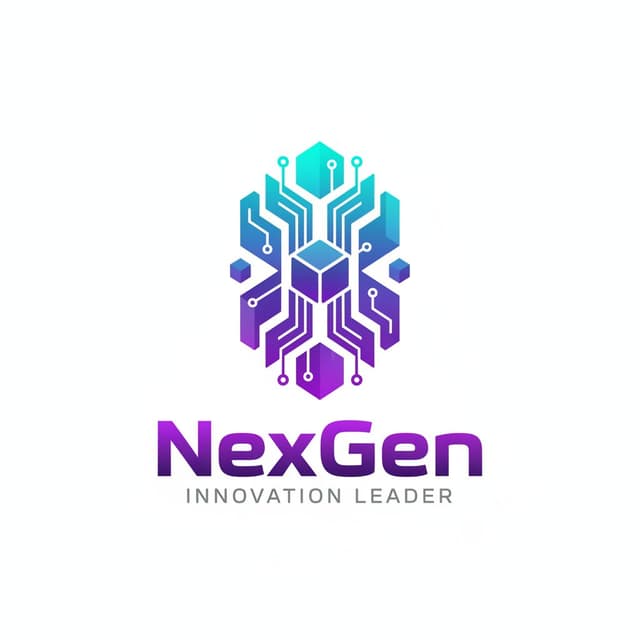
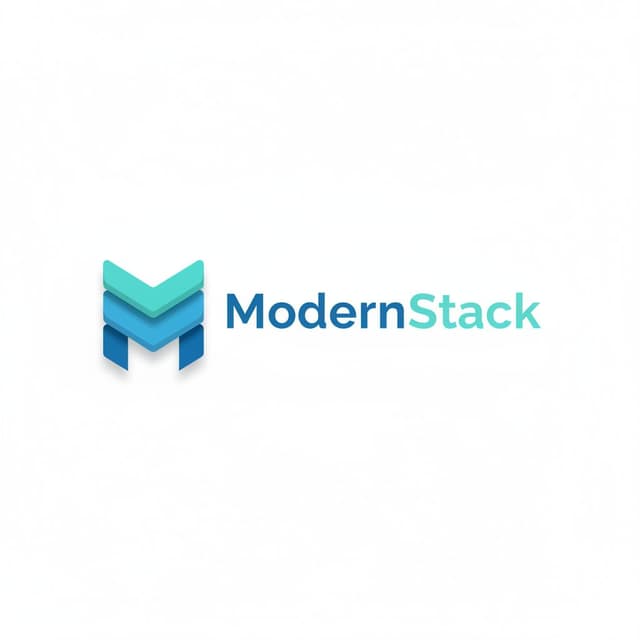


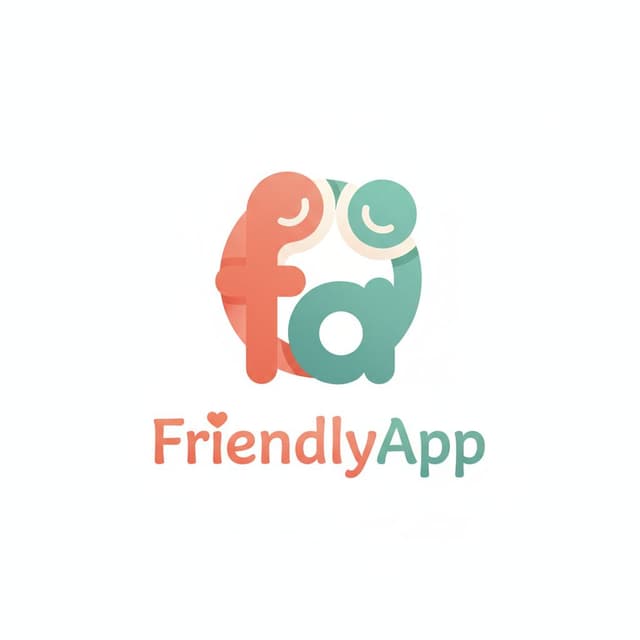
Frequently Asked Questions
Everything you need to know about startup logo design
Q:What makes a startup logo different from a corporate logo?
Startup logos need to look credible to investors while being budget-friendly, work across pitch decks and product UIs, scale from pre-seed to IPO, and be flexible enough to survive pivots. Corporate logos are optimized for consistency in established markets. Startup logos are optimized for growth and adaptability.
Q:How much should a startup spend on a logo?
Pre-seed/bootstrapped: $10-$100 (AI logo makers like GoodLogoAI). Post-seed with funding: $500-$2,000 (freelance designer). Series A+: $5,000-$20,000 (agency with full brand system). Don't overspend early—save cash for product and growth. Many unicorns started with simple, affordable logos.
Q:Will investors judge my startup by its logo?
Yes, absolutely. 72% of investors say branding influences their perception of founder competence. An amateur logo suggests you don't pay attention to details or understand your market. A professional logo (even if inexpensive) signals you're serious and credible. It's not fair, but it's reality.
Q:Should my startup logo tell a story or just look good?
Both, but story > aesthetics for startups. Airbnb's logo has meaning, which got them PR. Amazon's A-to-Z arrow tells their story. Robinhood's feather connects to their mission. A logo with meaning gives you content for investor pitches and press coverage. Pure aesthetics are forgettable.
Q:What if my startup pivots—do I need to rebrand?
Usually no. Most successful startups pivot without rebranding (Slack, Notion, YouTube all pivoted significantly). Your logo should be abstract enough to survive pivots. Only rebrand if you're changing company name, industry, or target market completely. Brand equity is valuable—don't throw it away.
Q:Do I need different logo variations for my startup?
Yes! You need minimum 4 versions: 1) Square icon (app, social media), 2) Horizontal logo (website header), 3) Black version (print, one-color use), 4) White version (dark backgrounds). GoodLogoAI provides all of these automatically. Don't launch with just one version.
Q:Should I match my competitors' logo style or be different?
Depends on your strategy. Match if you want to signal 'we belong in this category' (good for trust). Differentiate if you want to signal 'we're disrupting' (good for attention). Both work—just be intentional. Worst case: accidentally matching when you meant to stand out.
Q:Can I use an AI-generated logo for my funded startup?
Absolutely. What matters is professionalism, not creation method. Many successful startups use AI-designed logos. Investors care about your product, team, and market—not whether you spent $50 or $50,000 on your logo. Just make sure it looks credible.
Q:What file formats do I need for a startup logo?
You need: 1) Vector (SVG, PDF, or EPS) for infinite scaling as you grow, 2) High-res PNG (4096x4096px minimum) with transparency for all digital uses, 3) JPG for presentations and documents, 4) Multiple sizes (favicon 32x32, social media 512x512, etc.). GoodLogoAI provides all of these.
Q:Should my startup logo look 'safe' or 'disruptive'?
Match your positioning. Enterprise B2B targeting Fortune 500? Look safe and trustworthy (blue, simple, professional). Consumer app disrupting an industry? Look bold and different (unique colors, memorable shape). Your logo should match your pitch: 'We're the safe bet' vs 'We're the disruptor.'
Create Your Professional Startup Logo Now
Join 12,000+ founders who created investor-ready logos in minutes.
✨ Try free • No credit card • $9.99 to download • 30-day guarantee